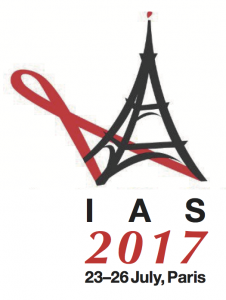Continued viral suppression with long-acting cabotegravir/rilpivirine injections: 96-week LATTE-2 results
10 August 2017. Related: Conference reports, Antiretrovirals, IAS 9th Paris 2017.
 Simon Collins, HIV i-Base
Simon Collins, HIV i-Base
Longer follow-up results from using the first coformulated injectable ART were presented from the phase 2b LATTE study. [1]
Following a lead period that included using oral formulations of cabotegravir and rilpivirine, 286 treatment-naive participants were randomised (2:2:1) to either 8-weekly (8W) or 4-weekly (4W) injections, or to oral cabotegravir plus abacavir/3TC.
Approximate baseline characteristics have been previously described and include 92% men, 80% white, CD4 489 cells/mm3 with 18% of participants having viral load >100,000 copies/mL.
The 96-week results presented at IAS 2017 maintained high levels of viral suppression to <50 copies/mL in 94%, 87% and 84% of participants in the 8W, 4W and oral groups respectively. Viral suppression with both injection schedules were non-inferior to oral dosing: 8W: difference +10.0% (95%CI: –0.6% to +20.5%) and 4W: +3.0% (95%CI: –8.4% to +14.4%). This compared to viral suppression rates at week-48 of 92%, 91% and 89%, respectively. [2]
Viral non-responses were more frequent in the 8W group (n=5 vs 0 vs 1) with only one case of viral failure in each of the 8W and oral arms.
Non-virological discontinuations occurred more frequently in the 4W group, with n=2, n=15 and n=8 in the 8W, 4W and oral groups respectively. The discontinuations in the 4W group included five drug-related causes: rash, QT prolongation, tachycardia, depression and psychosis and five non-drug related events.
Serious adverse events occurred in 10%, 10% and 13% in the 8W, 4W and oral groups respectively, but none were judged drug-related.
Injection site reactions (ISRs) were common (>80% at day 1 and at ~30 to 40% in injection arms throughout follow-up, occurring slightly more in the 8W group, but 84% overall were mild and 15% were moderate. Most common ISR events were pain (66%), nodules (8%), swelling (6%), and pruritus (6%). Median duration of ISRs was 3 days, with 89% resolving in <7 days. Only two participants (both in the 8W group) discontinued due to ISRs.
Participant satisfaction continued to be highest in the injection arms (99% rating 5/6 out of 6 to continue on present dosing, compared to 78% with the oral group).
The 96-week results were also published in the Lancet. [3]
comment
Phase 3 studies are currently ongoing using the 4W schedule selected based on week-48 results and all participants have the option to change to this dose after week 96.
Only one phase 3 study will continue to evaluate 8W dosing.
References:
- Eron J et al. Safety and efficacy of long-acting CAB and RPV as two drug IM maintenance therapy: LATTE-2 week 96 results. IAS 2017, Paris. Late breaker oral abstract MOAX0205LB.
http://programme.ias2017.org/Abstract/Abstract/5628 - Margolis D et al. Cabotegravir + rilpivirine as long-acting maintenance therapy: LATTE-2 week 48 results. AIDS 2016, 18-22 July 2016, Durban. Oral late breaker abstract THAB0206LB.
http://programme.aids2016.org/Abstract/Abstract/10517 - Margolis D et al. Long-acting intramuscular cabotegravir and rilpivirine in adults with HIV-1 infection (LATTE-2): 96-week results of a randomised, open-label, phase 2b, non-inferiority trial. The Lancet (24 July 2017). http://dx.doi.org/10.1016/S0140-6736(17)31917-7.
http://www.thelancet.com/journals/lancet/article/PIIS0140-6736(17)31917-7/fulltext

